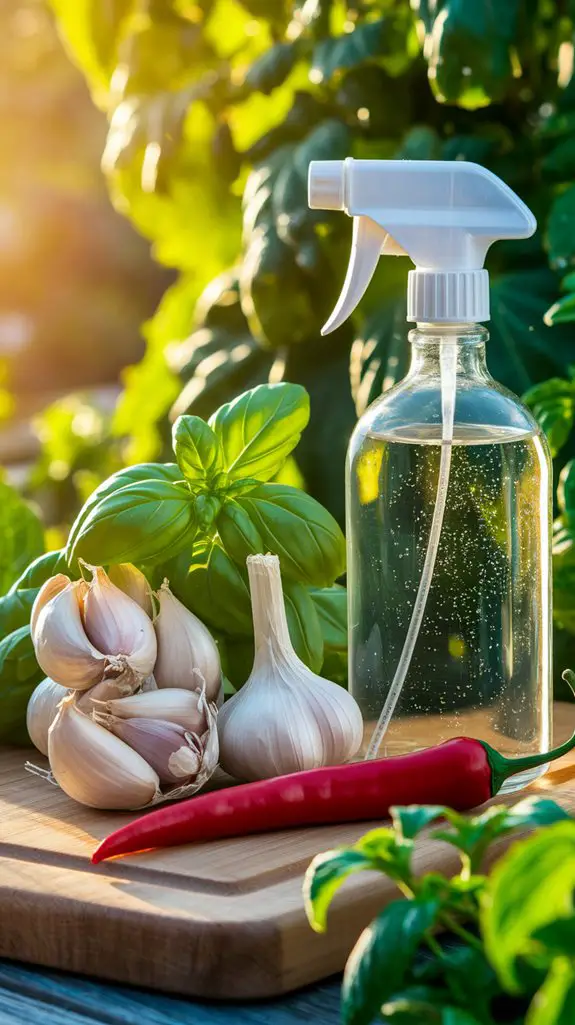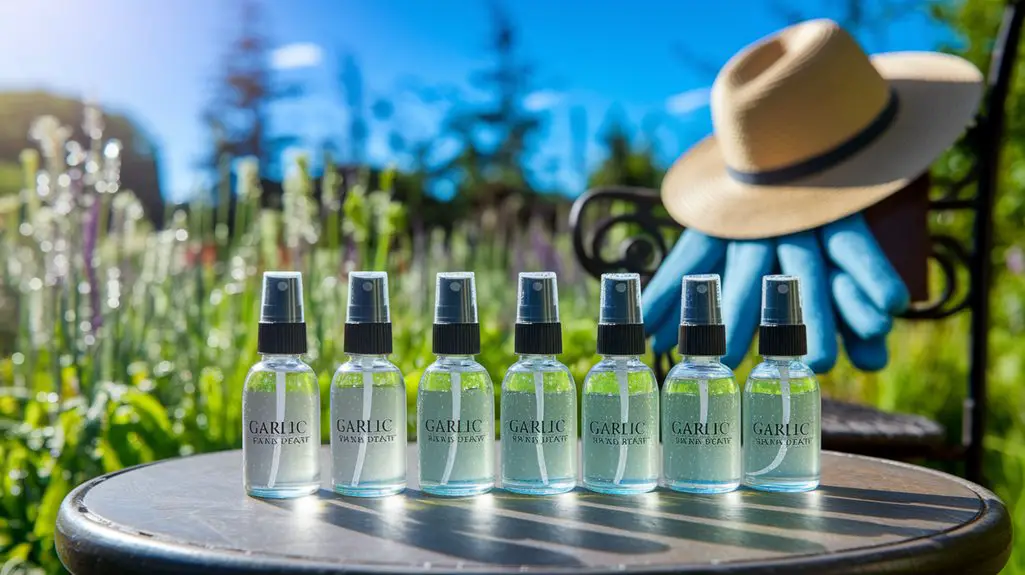You’ve probably spotted those garden pests munching away at your precious plants, wondering how to stop them without harsh chemicals. Garlic spray offers a potent, natural solution that’s both economical and environmentally sound. When prepared correctly, this pungent potion delivers sulfur compounds that repel and neutralize numerous garden invaders while keeping your soil and beneficial insects safe. The difference between mediocre results and transformative pest control often comes down to these seven essential techniques.
Why Garlic Spray Works Against Garden Pests
Packed with potent sulfur compounds that naturally repel insects, garlic spray works as a highly effective garden pest deterrent without introducing harmful chemicals to your ecosystem.
When you apply the spray, these compounds disrupt pests’ sensory receptors, making your plants unappetizing while preserving beneficial insects that help your garden thrive.
Unlike commercial pesticides that can leach into the soil and harm microorganisms, garlic’s natural properties break down organically, supporting your garden’s long-term sustainability.
You’ll find it particularly effective against aphids, spider mites, and whiteflies—common threats to vegetable gardens and flowering plants.
The sulfur in garlic also provides secondary benefits, adding trace nutrients to your soil and strengthening plants’ natural defense systems against disease.
It’s a regenerative approach that works with nature, not against it.
Essential Ingredients for a Potent Garlic Spray

The foundation of any effective homemade pest control solution begins with fresh, organic garlic bulbs—preferably locally grown for maximum potency.
You’ll need 4-6 cloves crushed to release allicin, the compound that repels insects.
Add a tablespoon of cold-pressed neem or mineral oil to help the solution stick to plant surfaces. For enhanced effectiveness, incorporate a teaspoon of biodegradable liquid soap as an emulsifier—castile soap works perfectly.
Mix these with one quart of filtered water, then boost potency with optional ingredients like cayenne pepper (½ teaspoon) or one tablespoon of diatomaceous earth. For fungal issues, add a tablespoon of baking soda.
Let your mixture steep for 24 hours before straining through cheesecloth to remove solids that might clog your sprayer.
Step-by-Step Garlic Spray Preparation Guide

With your ingredients gathered, it’s time to properly prepare your homemade garlic spray solution.
Peel 8-10 garlic cloves and crush them thoroughly in a mortar and pestle to release their potent sulfur compounds. Transfer to a heatproof container and add 2 cups of boiling water. Let this steep overnight to extract maximum potency.
The next day, strain the mixture through a fine mesh sieve, then add 1 tablespoon of organic liquid castile soap to help the solution adhere to plant surfaces.
Dilute with 4 cups of water in a spray bottle. For enhanced efficacy, consider adding 1 tablespoon of neem oil or 1 teaspoon of cayenne pepper. Incorporating natural pest solutions can further improve your garden’s resilience against unwanted insects.
Store your eco-friendly repellent in a cool, dark place and shake well before each application. Use within two weeks for peak potency.
Best Application Techniques for Maximum Effectiveness
Proper application of your garlic spray guarantees you’ll get maximum pest-fighting benefits while protecting beneficial insects.
Always apply during early morning or late evening when beneficial pollinators are less active and temperatures are cooler, allowing the solution to adhere effectively to plant surfaces.
For ideal results, follow these key techniques:
- Target undersides of leaves where pests often hide and feed, ensuring complete coverage without drenching plants to runoff.
- Reapply after rainfall or every 5-7 days during active infestations to maintain protection as the natural solution breaks down.
- Use a fine mist setting on your sprayer to create even coverage with minimal solution waste, maximizing your homemade remedy’s efficiency.
Always test on a small area first to guarantee plant compatibility before widespread application.
Optimal Timing and Frequency for Garlic Spray Applications
Timing your garlic spray applications strategically throughout the growing season will dramatically improve your pest control success while reducing the need for harsh chemical alternatives.
Apply your first treatment at the earliest sign of pests or before they typically emerge in your region—usually early spring when temperatures consistently reach 50°F.
For maintenance, spray every 10-14 days during peak pest seasons, but increase to weekly applications during pest outbreaks or after heavy rain washes away previous treatments.
Dawn and dusk are ideal application times when beneficial insects are less active and plants can absorb the solution before intense sunlight.
Avoid spraying during flowering to protect pollinators and pause applications three days before harvest to allow the garlic scent to dissipate from your edible crops.
Target Pests and Protective Plants for Garlic Spray Use
Garlic spray effectively targets a wide range of common garden pests while remaining safe for most beneficial insects when properly applied. Its sulfur compounds disrupt the nervous systems of soft-bodied pests like aphids, spider mites, and whiteflies, while deterring larger insects through its potent odor.
Your vegetable garden will particularly benefit from this natural deterrent, especially:
- Tomatoes, peppers, and eggplants – protection from aphids and spider mites
- Brassicas (cabbage, kale, broccoli) – defense against cabbage worms and loopers
- Roses and ornamentals – prevention of common sap-sucking insects
While highly effective, avoid spraying garlic solution on beneficial-attracting plants like dill and fennel, as you’ll want to preserve these habitats for predatory insects that provide additional pest control.
Common Mistakes to Avoid When Using Garlic Spray
When making and applying homemade garlic spray, many gardeners unintentionally compromise its effectiveness through several common errors.
Don’t use aluminum containers or utensils which react with garlic’s compounds, reducing potency. Avoid applying during peak sunshine hours as UV rays quickly degrade the active ingredients.
You’ll limit effectiveness if you dilute the mixture too much—follow the 1:10 garlic-to-water ratio for best results.
Many gardeners spray only leaf tops, missing undersides where pests often hide. Don’t forget to strain your mixture thoroughly to prevent clogging your sprayer.
Applying immediately after rainfall or before expected precipitation washes away your spray before it can work.
Finally, don’t store mixed solutions longer than two weeks, as fermentation reduces pest-repelling properties.
Conclusion
As your garden awaits protection, you’ve now unfastened nature’s secret weapon against unwanted visitors. What happens next? With each spray of your garlic solution, you’re not just defending plants—you’re nurturing an ecosystem that thrives without chemical intervention. Will your garden become the sustainable haven you’ve envisioned? The answer unfolds with each application of this ancient remedy, nourishing both soil and soul.




